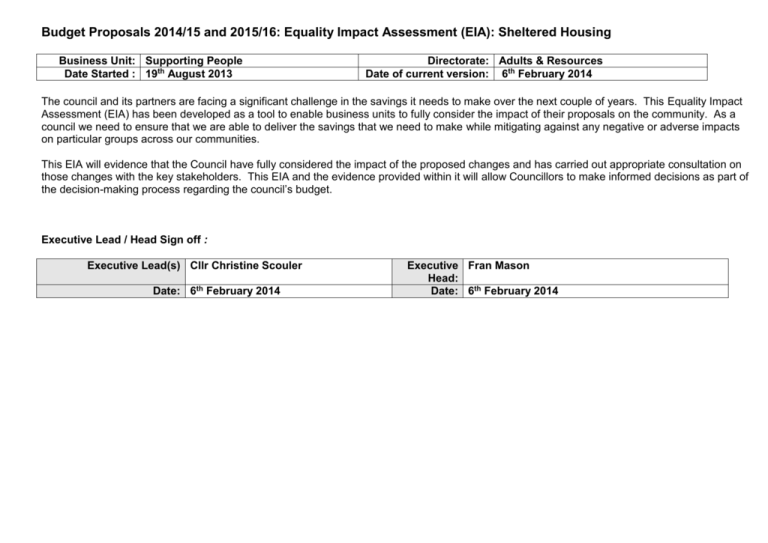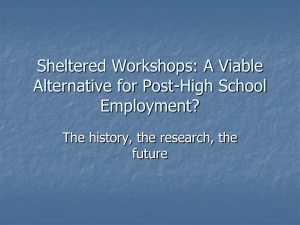Budget Proposals Proforma: Impact and Engagement
advertisement

Budget Proposals 2014/15 and 2015/16: Equality Impact Assessment (EIA): Sheltered Housing Business Unit: Supporting People Date Started : 19th August 2013 Directorate: Adults & Resources Date of current version: 6th February 2014 The council and its partners are facing a significant challenge in the savings it needs to make over the next couple of years. This Equality Impact Assessment (EIA) has been developed as a tool to enable business units to fully consider the impact of their proposals on the community. As a council we need to ensure that we are able to deliver the savings that we need to make while mitigating against any negative or adverse impacts on particular groups across our communities. This EIA will evidence that the Council have fully considered the impact of the proposed changes and has carried out appropriate consultation on those changes with the key stakeholders. This EIA and the evidence provided within it will allow Councillors to make informed decisions as part of the decision-making process regarding the council’s budget. Executive Lead / Head Sign off : Executive Lead(s) Cllr Christine Scouler Date: 6th February 2014 Executive Fran Mason Head: Date: 6th February 2014 Summary from Overall Budget Proposals: Sheltered housing: Accommodation based support for older people living in the social housing sector. Annual contract value: £305,700 this is the figure in our budget savings and is the allocated budget Budget reductio n £ 000’s Reduce by 100%: £305,700 April 2014 not identified early resulting in an increased demand for other services such as adult social care. There is the potential for loneliness and isolation among clients. Consultation and Equality Impact Assessment undertaken to assess the impact of the proposal. Major Income £ 000’s Type of decision Minor Proposals – Outline Implementation Cost Include brief outline + year incurred Delivery When will this proposal realise income / savings Risks / impact of proposals Potential risks Impact on community Knock on impact to other agencies If statutory service please state relevant legislation section and Act together with any statutory guidance issued. Contracts expire 17 March 2014 There is the potential that needs are Internal Savings for 2014/15 and 2015/16 X Section 1: Purpose of the proposal/strategy/decision No 1. Question Clearly set out the proposal and what is the intended outcome. Details Sheltered Housing Services currently provide low level support (up to 1.5 hours per week) to between 630 and 700 residents in sheltered housing and have recently begun to offer this support to around 30-40 of people in the wider community. The proposal is to terminate all existing Sheltered Housing contracts when they are due to end on March 18th 2014 (4 in total) worth £305,700 If alternative, voluntary support can be made available to people then this could limit the impact of the proposal. However it is not clear to what extent this will be possible and what capacity or appetite there is for the voluntary sector to do so. 2. Who is intended to benefit / who will be affected? Sheltered Housing Residents – will either have their support removed, or will need to pay for support . Torbay and Southern Devon Care Trust – Potential risk of increased need for Domiciliary Care support Clinical Commissioning Group –there may be increase in hospital admissions and delayed discharge e.g. for falls etc Torbay and Southern Devon Care Trust (Adult Social Care) – As part of the developing Living Well@Home service (which will deliver an integrated Care and Support service across Torbay), it has been proposed that funding currently earmarked for Older People services in Supporting People would be used from 2015 to enable the support element of this contract to be delivered. The Living Well at Home service planned to join together both Domiciliary Care and Housing Support functions to create greater value for money services. Reductions in funding now could impact heavily on the preventative, Housing Support element of the Living Well @ Home service and limit the opportunities for integration between the Council and Adult Social Care. Wider community – without these resources available, future clients may lose independence and pressure could be placed on informal support networks including family and neighbours. Voluntary agencies such as Age UK – dedicated volunteers may have more opportunities to support people although this would put more pressure on their resources as a result . Key stakeholders affected are: No Question Details Sheltered Housing Providers, including staff employed within the service who may be subject to redundancy Sheltered housing residents Wider population of older people Housing Services Adult Social Care Clinical Commissioning Group Voluntary and community sector organisations such as Age UK Section 2: Equalities, Consultation and Engagement Torbay Council has a moral obligation as well as a duty under the Equality Act 2010 to eliminate discrimination, promote good relations and advance equality of opportunity between people who share a protected characteristic and people who do not. The Equalities, Consultation and Engagement section ensures that, as a council, we take into account the Public Sector Equality Duty at an early stage and provide evidence to ensure that we fully consider the impact of our decisions/proposals on the Torbay community. Evidence, Consultation and Engagement No 3. 4. Question Have you considered the available evidence? How have you consulted on the proposal? Details Current population trends point to an increase in older people both nationally and locally, which will most likely lead to an increase in need for support and care services in the future. Providers of Supporting People funded services The consultation period ran from Thursday 21 November 2013 to 16 January 2014 On 21st November Providers were sent written details outlining the proposal(s) for their service(s) and given the Consultation Summary document detailing the overall proposals for the Supporting People (SP) programme, draft Equality Impact Assessments (EIAs) for their services and access to view the EIAs of other services online. Initial provider meetings/conversations were set up with SP Contract Managers in the week prior to the formal draft budget announcement. This was to explain the proposals and consultation process to providers and to allow the providers time to arrange meetings with their staff to take place on the day of the budget announcement (as for many services the proposals will affect staff) No Question Details A client profile template was developed and sent to Providers to complete to identify clients in support services who were also in receipt of a statutory service. This information was used to inform the service EIAs and evidence where there might be an impact on the expenditure in other parts of the Authority. The Consultation Summary document and questionnaire were available on the Supporting People page of the Council’s website. A follow up email was sent to Providers on 8th January asking if they were responding collectively, individually or both; and asking them to encourage referral agencies to respond to the consultation. Current and previous users of Supporting People funded services, and their carers, relatives and advocates. A standard letter outlining the specific proposals for each service was sent to the service provider to distribute to their service users. The letter outlined where service users could access and complete the client consultation questionnaire and explained the consultation process including the opportunity to attend focus groups or face to face interviews. Posters were sent to Providers to insert the details of the consultation events and promote these to service users. A number of focus groups proportionate to size of service were held for each of the affected services. Where services had more than 20 clients then 2 focus groups were offered, with the option for more if required, subject to the availability of resources to facilitate them. Focus groups used the same questions as the client questionnaire. However 1 focus group for clients in the supported employment service used different questions, chosen by the external agency that facilitated this particular group. Focus groups were facilitated by representatives from Torbay Voice with a member of the SP team present to record comments. Where a focus group was organised but there were no attendees, the focus group has not been counted. Face to face interviews (with Torbay Voice representatives) or telephone interviews were offered to those choosing not to or unable to attend focus groups using the same questions. There may be a small duplication of respondents as some may have completed a questionnaire as well as attended a focus group Providers were encouraged to undertake their own consultations using the same questions, and some providers issued the questionnaires to their clients. The client questionnaire was available on the SP page of the Council’s website and providers advised of this so that they could direct service users to it, or support service users to complete it themselves. No Details Question Individual written submissions (email and letter) were received from service users, relatives, and family members. Stakeholders including statutory partners, referral agencies, local and national partner organisations An email was sent to all stakeholders attaching the SP Consultation Summary document and stakeholder questionnaire, a summary of SP services and a link to the EIAs for each service. Stakeholders were also encouraged to respond to the overall Council budget proposals and a link to the wider Council budget consultation was included in the email. Stakeholders included: Torbay and Southern Devon Health and Care NHS Trust Devon Partnership Trust Devon and Cornwall Probation Trust South Devon Clinical Commissioning Group Torbay Council Housing Services Torbay Council Children’s Services Police Referral agencies such as: Community Mental Health Teams, Disability Information Service, Housing Options team, Torbay Hospital Other local and national partners such as: British Association of Supported Employment, Shelter, The Alzheimers Society, MIND and Mencap See Appendix 1 for consultation results. Other including members of the public/non service users A general questionnaire was placed on the Council’s website by the Council’s Policy and Performance Team asking about all of the Council budget proposals including a section on Supporting People. The SP section contained a link to the SP consultation documentation on the specific budget proposals for SP services. Further representations were made in writing (via letter, email and petition) by organisations and members of the public. A total of 285 representations were received, as well as 21 focus groups that were facilitated for clients and carers, where 160 people attended. No 5. Details Question Outline the key findings There were 40 responses received which referred to this proposal. This included a petition signed by 306 people. There were also 4 focus groups held for clients where 37 people attended. The overriding concern raised by sheltered housing residents was that the cut in funding would leave them vulnerable, alone, isolated and depressed with no one to support them. They like the fact that they are in a secure building and there is always someone available to provide help. Many feel they are able to live independently and manage better because they know someone is there if needed. Respondents identified a number of impacts on other statutory services which they felt would result from ending the support, including increased unplanned hospital admissions (including increased call on the ambulance service), increased length of stay in hospital, increased likelihood of readmission to hospital within 28 days of discharge and an increased number of people moving into residential care. It was stated that the Cap-gemini study in 2009 found that the net financial benefits on the Supporting People programme for those in sheltered housing were £646.9m against an overall investment of £198.2m, making the likely costs of ending the service triple the level of current investment. There was also concern expressed around the risk of people losing their homes, if they did not have the help needed to maintain their tenancy or manage their finances. Service users were worried about the increased risk they might pose to others or that other might pose to them. The providers who responded highlighted issue of staff redundancies and the knock-on effect of staff potentially applying for benefits whilst they seek alternative employment. On a wider basis they also raised the issue of how allocations into sheltered housing may be managed in the future if support is withdrawn, which will make it more difficult for some people to maintain their tenancy. 6. What amendments may be required as a result of the consultation? Provider organisation and Police, probation and health services requested a delay in implementation of the proposals so that alternative sources of funding can be investigated. Positive and Negative Equality Impacts No Question Identify the potential 7. Details No Question Details positive and negative impacts on specific groups Positive Impact Older or younger people People with caring responsibilities Negative Impact Older people may be at greater risk of social isolation, falls and need for help from statutory services etc. Those living in the community may find it harder to maintain a tenancy Potential for more pressure on carers to support older people with less opportunity for respite or other support for themselves. Neutral Impact People with a disability No differential impact Women or men No differential impact People who are black or from a minority ethnic background (BME) Religion or belief (including lack of belief) People who are lesbian, gay or bisexual People who are transgendered People who are in a marriage or civil partnership No differential impact No differential impact No differential impact No differential impact Support given through Sheltered Housing to bereaved partners may be lost. Women who are pregnant / on maternity leave Socio-economic impacts No differential impact The loss of support for older people to No Question (Including impact on child poverty issues and deprivation) 8a. Public Health impacts (How will your proposal impact on the general health of the population of Torbay) Cumulative Impacts – Council wide (proposed changes elsewhere which might worsen the impacts identified above) Details live independently could lead to an increased risk of homelessness – malnutrition, and other health issues Increased pressure on other council budgets are also likely, particularly the Adult Social Care budget as older people become unable to cope living at home in the wider community. Potential issues with malnutrition as well as mental health issues (e.g. depression) brought on by increased isolation. The proposal to reduce Supporting People floating support services (community based support) will mean that there is a negative cumulative impact as the proposal states a 100% reduction to floating support so clients in sheltered will not be able to access any other generic service for support. The budget proposal for Folks@home, (a specialist older persons floating support service) is to reduce by 48%. The cumulative impact of this will be increased waiting times for older people requiring a housing support service. 8b. Cumulative Impacts – Other public services (proposed changes elsewhere which might worsen the impacts identified above) Cumulative impact of proposed reductions across services and increasing reliance on voluntary sector will impact on voluntary sector capacity. Section 3: Mitigating action No 9. Action Summarise any negative impacts and how these will be managed? Details 1. Older people may be at greater risk of social isolation, falls and need for help from statutory services etc. Those living in the community may find it harder to maintain a tenancy 2. Potential for more pressure on carers to support older people with less opportunity for respite or other support for themselves. 3. Support given through Sheltered Housing to bereaved partners may be lost. 4. The loss of support for older people to live independently could lead to an increased risk of homelessness – malnutrition, and other health issues 5. Increased pressure on other council budgets are also likely, particularly the Adult Social Care budget as older people become unable to cope living at home in the wider community. 6. Potential issues with malnutrition as well as mental health issues (e.g. depression) brought on by increased isolation. Whilst increased engagement with voluntary agencies will offer some level of service to offset that lost, the greater the reduction in contract value will impact on how much assistance these agencies will be able to provide in the short term. Alternatively, some of the cost of support could be passed on to clients i.e. In the case of sheltered housing the cost of alarm provision could be transferred to residents, meaning that 1-1 support may not be affected by a reduction in contract value. It should be noted that for those on the lowest income, there may not be the capacity to pay for this. The implementation of a financial assessment to determine ability to pay could be considered, although new administrative procedures would need to be set up to accommodate this. The ability to mitigate risks is also minimised through the cumulative effect of the proposed reductions of Supporting People services as they will be no other services to offer support. Section 4: Monitoring No 10. Action Outline plans to monitor the actual impact of your proposals Details The following impacts will be monitored and reported to Commissioning for Independence Board, Chaired by the Director of Adult Services Possible plans could be: Monitor the number of people from Sheltered Housing visiting A&E Monitor number of moves from Sheltered housing into Residential Care Monitor hospital discharge rates Monitor for increase in respite care Monitor for increase in number of people accessing Residential Care and reasons These results will not only illustrate any impact of the proposals but also inform future commissioning plans within Torbay Council, Adult Social Care and/or Clinical Commissioning Group Section 5: Recommended course of action – No Action Outcome 11. State a recommended course of action Outcome 1: No major change required - EIA has not identified any potential for adverse impact in relation to equalities and all opportunities to promote equality have been taken Tick Reasons/justification for recommended action Outcome 2: Adjustments to remove barriers – Action to remove the barriers identified in relation to equalities have been taken or actions identified to better promote equality Outcome 3: Continue with proposal - Despite having identified some potential for adverse impact / missed opportunities in relation to equalities or to promote equality. Full justification required, especially in relation to equalities, in line with the duty to have ‘due regard’. Outcome 4: Stop and rethink – EIA has identified actual or potential unlawful discrimination in relation to equalities or adverse impact has been identified The purpose of this proposal is not to discriminate directly or indirectly, and does not amount to unlawful discrimination. The Council has to deliver significant savings, and in doing so has to prioritise its statutory responsibilities. Whilst the consultation has highlighted the benefits derived from the service together with the impact upon those who currently receive the service, this service is not statutory. The Council will endeavour, with its partners and the community, to mitigate against any adverse impacts. If any individual affected by the decision meets the FACS criteria, they will receive a service to meet their needs from Torbay & Southern Devon Health & Care Trust. Appendix 1 Consultation Results: Sheltered Housing- Reduce by 100% There were 40 responses received which referred to this proposal. This included a petition signed by 306 people. There were also 4 focus groups held for clients where 37 people attended. These services are provided by Sanctuary Housing, Westward Housing, Guinness Care and Support and Independent Futures. Category Examples of comments “The removal of the service will impact on the well-being and safety of service users. The type of support provided which impacts on health etc. have been summarised below: Impact on the Health, Wellbeing and Quality of Life of Existing and Potential Clients Increase incidence of unplanned hospital admissions, as a result of no falls prevention work & no proactive support to assist in maintaining health. Increased length of stays in hospital. Increased likelihood of readmission to hospital within 28 days. Increased likelihood of moving into registered care. Increased ill-health and use of PCT services. Increased reliance on family and friends, if they live locally. Increased fear of crime, and increased incidence of ASB. Risk of losing their home as no support to assist individuals to maintain their tenancy. Increase of safeguarding risks and risks not being managed effectively. Vulnerable service users will be put at risk from themselves and others. Increased risk of social isolation which could impact on mental health and increase cases of depression. Decrease in quality of life and independence.” Client responses highlighted issues of isolation and loneliness, linked with deteriorating mental and physical health. Category Examples of comments “These cuts will have a significant impact on all of us who live in Sheltered Housing, leaving us vulnerable, alone, isolated and depressed with no one to support us”. Focus groups highlighted the support with Finances, bills and paperwork and other tasks that enable people to continue to live independently “Other statutory bodies will also be impacted by the proposal to reduce funding by 100%. These include: Impact on Statutory Services and National Priorities • • • Increased use of emergency front line services, especially paramedics. Increased length of stay in hospitals. Increased re-admission to hospital within 28 days. • Increased risk of social isolation, which could impact on mental health and increase cases of depression. “ Many of the client responses reflected the quote below from the Westward Housing petition. “Many of us will experience increasing mental, physical and emotional health problems of which the impact on the medical professions and hospital admissions will significantly increase, as will the increase of care home placements and the additional costs this will incur as many resident's will not be able to live un-supported without help.” People at the focus groups suggested that they would end up in residential homes or rely more on Social services and nurses. Financial Impact of the Proposals “The Capgemini study in 2009 found that the net financial benefits on the Supporting People programme for those in sheltered housing were £646.9m against an overall investment of £198.2m. Therefore the likely costs should the service be removed are triple the current investment.” Category Examples of comments “These figures are supported by a recent impact assessment carried out by another Supporting People team (Cornwall Council). The funding for sheltered housing services was cut by 40%. The impact assessment showed that following the cut, the number of people receiving a domiciliary care package increased by 30%”. Impact on the Service / Provider Quality of service “The impact of the proposals could be that all staff face redundancy. This in turn will have an impact on Torbay Council, as staff seek alternative employment and apply for benefits to support them in the interim.” “On a wider basis, the withdrawal of support from our sheltered housing services will also have an impact on Sanctuary. With over 350 units of accommodation, consideration will have to be given to how we manage future allocations.” “I like the fact I can trust and rely on the support advisors at all times, and I am not judged by them.” Focus groups emphasised the important of the support worker’s knowledge of each individual resident so that they are aware when something is “not right”. Safety and Security “I like the fact that I am in a secure building and there is always help on sire and through the Call 24 system. I would not have been able to manage and improve my quality of life if this had not been available.” “Helped me get on to my feet and given me confidence. It has also made me feel secure that if I had any health or emotional problems, I would be able to manage because someone was there for me.” Opportunities to Discuss Alternative Options / Source Other Funding “We propose that a group consisting of Council officers and providers meets together urgently to plan and prospose alternatives.” “We would have welcomed the chance to have worked with you to identify savings within our services, this is the approach we have taken with other local authorities. Category Examples of comments We are still open to work with you to look at how services can be secured.” “The budgetary problem will not be solved in isolation it can only be achieved through agencies both statutory and voluntary working together that includes the Council in working with the new Clinical Commissioning Group around saving or future partnership working and integration of social care funding









